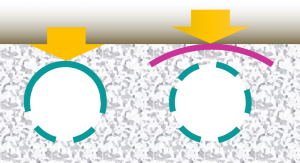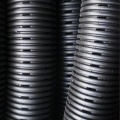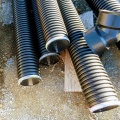Difference between revisions of "Pipes"
Jump to navigation
Jump to search
Jenny Hill (talk | contribs) m |
Jenny Hill (talk | contribs) m |
||
| Line 1: | Line 1: | ||
| − | |||
[[File:Perforations.png|thumb|Pipes are available with perforations on just one side, these should be situated on the lower half of the pipe. Pipes with 360° perforations should have a strip of geotextile or membrane placed over the pipe to reduce the migration of fines from overlying media.]] | [[File:Perforations.png|thumb|Pipes are available with perforations on just one side, these should be situated on the lower half of the pipe. Pipes with 360° perforations should have a strip of geotextile or membrane placed over the pipe to reduce the migration of fines from overlying media.]] | ||
Perforated pipes are a common component of [[underdrains]], [[infiltration trenches]] and [[exfiltration trenches]]. | Perforated pipes are a common component of [[underdrains]], [[infiltration trenches]] and [[exfiltration trenches]]. | ||
| Line 10: | Line 9: | ||
**A perforated pipe with many rectangular slots has better drainage characteristics than a pipe with similar open area provided by fewer circular holes <ref>Hazenberg, G., and U. S. Panu (1991), Theoretical analysis of flow rate into perforated drain tubes, Water Resour. Res., 27(7), 1411–1418, doi:10.1029/91WR00779.</ref>. | **A perforated pipe with many rectangular slots has better drainage characteristics than a pipe with similar open area provided by fewer circular holes <ref>Hazenberg, G., and U. S. Panu (1991), Theoretical analysis of flow rate into perforated drain tubes, Water Resour. Res., 27(7), 1411–1418, doi:10.1029/91WR00779.</ref>. | ||
*Non-perforated pipes should be used for conveyance to and away from the facility, including overflow. | *Non-perforated pipes should be used for conveyance to and away from the facility, including overflow. | ||
| + | <gallery> | ||
| + | Perforated Pipe 550x550.jpg|Pipe with slotted perforations | ||
| + | Pipe with connector.jpg|Perfroated pipes on job site, note the 30 degree connector used to facilitate maintenance. | ||
| + | </gallery> | ||
| + | See also: [[flow through perforated pipe]] | ||
---- | ---- | ||
[[Category:Materials]] | [[Category:Materials]] | ||
Revision as of 13:37, 14 March 2018
Perforated pipes are a common component of underdrains, infiltration trenches and exfiltration trenches.
Pipes should have been manufactured in conformity with the latest standards by the Canadian Standards Association (CSA) or ASTM International.
- Perforated pipes should be continuously perforated, smooth interior HDPE (or equivalent material) with a minimum inside diameter of 100 mm.
- Smooth interior facilitates inspection and maintenance activities; internal corrugations can cause cameras or hydrojetting apparatus to become snagged.
- Where freezing is a concern, horizontal underdrain pipes should be over-sized to a minimum 200 mm diameter.
- Perforations should be made on all sides of the pipe and provide a ≥ 1 m2 of open area per linear meter of pipe.
- A perforated pipe with many rectangular slots has better drainage characteristics than a pipe with similar open area provided by fewer circular holes [1].
- Non-perforated pipes should be used for conveyance to and away from the facility, including overflow.
See also: flow through perforated pipe
- ↑ Hazenberg, G., and U. S. Panu (1991), Theoretical analysis of flow rate into perforated drain tubes, Water Resour. Res., 27(7), 1411–1418, doi:10.1029/91WR00779.


